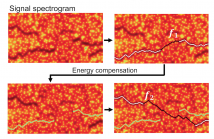- DSP algorithm implementation in hardware and software
- Compilers and tools for DSP implementation
- Algorithm and architecture co-optimization
- Programmable and reconfigurable DSP architectures
- Low-power signal processing techniques and architectures
- System-on-chip architectures for signal processing

- Categories:
 16 Views
16 Views
- Read more about ENHANCING BEAMFORMED FINGERPRINT OUTDOOR POSITIONING WITH HIERARCHICAL CONVOLUTIONAL NEURAL NETWORKS
- Log in to post comments
poster.pdf
- Categories:
 18 Views
18 Views
- Read more about Enhanced Recurrent Neural Network for Combining Static and Dynamic Features for Credit Card Default Prediction
- Log in to post comments
Deep learning models have been shown to be capable of extracting high-level representations from the increasing amount of customer-level data generated via fast-growing financial activities. In financial data, dynamic features that evolve with time are commonly observed. However, such time dependencies are often ignored in classical classification models. In this study, we propose to learn a Recurrent Neural Network (RNN) feature extractor with GRU on credit card payment history to leverage the time dependencies embedded in these dynamic features.
- Categories:
 133 Views
133 Views
- Read more about GPU-BASED IMPLEMENTATION OF BELIEF PROPAGATION DECODING FOR POLAR CODES
- Log in to post comments
Belief Propagation (BP) decoding provides soft outputs and features high-level parallelism. In this paper, we propose an optimized software BP decoder for polar codes on graphics processing units (GPUs). A full-parallel decoding architecture for codes with length n ≤ 2048 is presented to simultaneously update n/2 processing elements (PEs) within each stage and achieve high on-chip memory utilization by using
- Categories:
 38 Views
38 Views
In this work, we study the problem of tracking multiple frequency components in a noisy signal using a spectrogram-based method. Previous approaches such as image processing based or hidden Markov model-based methods may not be capable of tracking multiple frequency components, may require extensive training, and may be time-consuming. To address these issues, we propose an accurate and efficient method named Adaptive Multi-Trace Carving (AMTC) for tracking multiple frequency traces by iterative forward and backward dynamic programming and adaptive trace compensation.
- Categories:
 342 Views
342 Views
- Read more about JOINT CONTENT POPULARITY PREDICTION AND CONTENT DELIVERY POLICY FOR CACHE-ENABLED D2D NETWORKS: A DEEP REINFORCEMENT LEARNING APPROACH
- Log in to post comments
Compared with traditional device-to-device (D2D) communication networks, the users in the cache-enabled D2D communication networks can easily obtain their requested contentsfromthenearbyusers,andreducethebackhaulcosts. In this paper, we investigate the caching strategy for the cacheenabled D2D communication networks, with the consideration of caching placement and caching delivery. The content popularity and user mobility are predicted by a machine learning approach of echo state networks (ESNs) in order to determine which content to cache and where to cache.
- Categories:
 23 Views
23 Views
- Categories:
 6 Views
6 Views
- Read more about Efficient Deep Convolutional Neural Networks Accelerator without Multiplication and Retraining
- Log in to post comments
- Categories:
 19 Views
19 Views